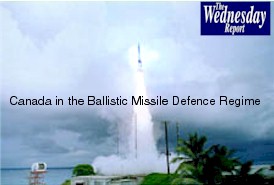| Home | TWR Index | The Editor | Comments | Current Issues |
 |
 |
| Last Week ~ Next Week ~ This Week's Entire Issue | |
|
Volume 18, Number 20, May 12, 2004 |
|
CommentThe [U.S.] Missile Defense Agency's mission is to develop and field an integrated Ballistic Missile Defense System capable of providing a layered defense for the United States and its deployed forces, friends and allies against ballistic missiles of all ranges in all phases of flight. MDA is responsible for research, development, testing and evaluation. Using complementary interceptors, sensors, and battle management command and control systems, the planned missile defense system will be able to engage all classes and ranges of ballistic missile threats. Missile defense elements being developed and tested by MDA are primarily based on hit-to-kill technology. It has been described as hitting a bullet with a bullet a capability that has been successfully demonstrated in test after test.
-- U.S. Missile Defence Agency Canada in the Ballistic Missile Defence RegimeGuidance systems sold by North Korea to enhance the accuracy of Syria's medium-range Scud D missiles is atrociously inaccurate according to data gathered by watchers in Israel, but it nevertheless takes the indigenous Syrian project to a new dimension. Israel must take this weapon system seriously and make certain that it's home grown anti-missile missile system is up to snuff. The Scud D is an old dog of a medium-range weapons delivery system, widely available, getting a new life from a handful of modern micro-chips. Almost anyone can do it. Iran's Shahab-6 has the potential of striking Toronto, Canada with three rocket stages. North Korea's Taepo Dong-2 could deliver a substantial nuclear payload to Vancouver. A three-stage variant could delete Montreal from the map. Would Iran or North Korea ever want to kill Canadians? No, it is hard to concoct any reasonable expectation of that happening, so why worry about the capability if motive can't be found?
Why would anyone want to attack a Canadian city? Blackmail? Retaliation against one of Canada's alliances? Demonstrate to the U.S. a capability to kill many millions of people by devastating a small Canadian city?
An inter-continental missile launched from a rogue state or by non-state operators from half way around the globe would likely carry a significant chemical, biological or nuclear payload. Technology, delivery systems and warheads as well as know-how are all available for a high price in cash dollars in the right place at the right time. This is not a stretch. This is today's reality. Meanwhile, although on May 29, 2003, Ottawa announced that Canada would enter into discussions with the U.S. about possible Canadian participation in the missile defence of North America, Canada's current plan for dealing with such a threat is still limited to diplomatic engagement with proliferators, export controls on missile-related technology, membership in the Missile Technology Control Regime (MTCR), and support for the Hague Code of Conduct on ballistic missiles. Notwithstanding these valiant international 'Boy Scout' efforts, Canada is therefore extremely vulnerable inasmuch as the United States is vulnerable without a viable ballistic missile defence system. In this danger, we and the U.S. are inseparably joined at the hip. By the year 2010, if not earlier, a missile attack traversing Canadian territory or into Canada is more than possible, it's a probability. It is therefore an obligation of the Canadian federal government, no matter what opinion polls may indicate, to provide Canadians with defensive capability against missile attack or against errant missile hits by joining the U.S. and our mutual allies in the creation of the North American missile defence system. The advantage of gaining a technological lead of at least five years over enemies and proliferators is a proven thing. The Canada / U.S. North American Missile Defence system is the next best step for NORAD. Micheal O'Brien, Editor Ed. Note: Additional reading: Discussions
with the United States on possible Canadian participation in the Ballistic
Missile Defence of North America. Recent Missile Defence Agency MilestonesMay 3The Missile Defense Agency (MDA) successfully conducted a demonstration launch of a Long Range Air Launch Target (LRALT) at 12:06 a.m. (EDT) Monday, May 3, 2004. The LRALT missile boosted a simulated reentry vehicle from a point just south of Midway Island to the vicinity of Kwajalein Atoll in the Marshall Islands. March 23The Missile Defense Agency (MDA) announced that Lt. Gen. James A.
Abrahamson, U.S. Air Force (Retired), is the second recipient of the Ronald Reagan Missile Defense Award, an annual honor awarded to individuals or organizations to recognize outstanding support, innovation, and engineering and scientific achievement associated with technologies designed to defend against ballistic missile attack. General Abrahamson was the first director of the Strategic Defense Initiative Organization (SDIO), the forerunner of the Missile Defense Agency, and served from March 27, 1984 to January 31, 1989. March 5The Ground-Based Midcourse Defense Site Activation Command announced that the construction project at the Fort Greely Missile Defense Site recently passed a major safety milestone: more than 2 million man-hours worked without a lost time accident. March 3The U.S Army conducted a successful intercept test flight
of the Patriot Advanced Capability-3 (PAC-3) missile at White Sands Missile Range, N.M., today at approximately 7 a.m. Mountain Standard Time. Preliminary test data indicate the missile successfully intercepted the target and mission objectives were achieved. January 9Team Vandenberg successfully launched Booster Verification Test-5 at 10:40 a.m. today. BVT-5 tested a three-stage booster configuration for use with the Missile Defense Agency's Ground-based Midcourse Defense System. Built by Lockheed Martin Corp., the booster is one of two slated for use with the GMD system. The system is designed to intercept and destroy long-range ballistic missiles. January 7Lockheed Martin Space Systems Company of Sunnyvale, Calif. is being awarded an indefinite delivery, indefinite quantity cost-plus-award-fee contract for the development and demonstration of a miniature kill vehicle (MKV) system. The maximum value of the contract is $768,000,000 performed over an eight-year period. The first task order for $27,000,000 will be awarded simultaneously with the contract award. The MKV program will be managed by MDA Advanced Systems, which is responsible for developing advanced capabilities for integration into the Ballistic Missile Defense System. The MKV contract will be executed for MDA Advanced Systems by the U. S. Army Space and Missile Defense Technical Center in Huntsville, Alabama. The MKV system will deploy multiple, small kill vehicles from a single carrier vehicle. The integrated payload will be designed to fit on existing and planned interceptor boosters. The resulting system will be capable of engaging multiple midcourse targets from a single launcher, adding firepower and robustness to midcourse defenses. The initial program focus will be on the design and demonstration of the kill vehicle. The MKV system will be designed to integrate seamlessly into the Ballistic Missile Defense System with initial focus on its Ground-based Midcourse Defense element.
|
|
| Copyright © 2004 MPRM Group Limited. All rights reserved.
Publisher and Editor In Chief: |
|